| کد مقاله | کد نشریه | سال انتشار | مقاله انگلیسی | نسخه تمام متن |
|---|---|---|---|---|
| 5765277 | 1626616 | 2017 | 13 صفحه PDF | دانلود رایگان |

- Measured SPM at different depths in and around mud banks of India.
- Near bed fluid muds with 0% optical transmission only during SW monsoon.
- Increase in grain size and bulk density and decrease in water content of sediments during monsoon months.
- Wave height decreased from 3.2Â m to 0.76Â m during the formation of fluid muds.
- Re-suspension of bottom sediment by wave activity caused fluid muds.
Time series measurements on suspended particulate matter (SPM) were made at one non-mud bank (M1) and two mud bank stations (M2 and M3) off Alleppey, south west coast of India. The mean SPM was low in surface (6.2 mg/l) and mid-depth (3.7 mg/l) waters and higher in bottom-depth waters (24.6 mg/l) of these stations, during both pre-monsoon and monsoon seasons. Near bed suspended sediment results indicated low SPM during July (0.042 g/l) and September (0.018 g/l) at M1, but very high SPM at M2 (9.2 g/l) and M3 (6.2 g/l) during July that decreased (M2: 0.033 g/l; M3: 0.1 g/l) again in September. Observations based on LISST-25X indicated that optical transmission (OT) was high (80-100%) in surface and mid-depth waters but decreased with increasing depth. Near bed waters at M2 and M3 stations showed â¼1 m thick fluid layer with 0% OT and with high particle volume concentrations (150-200 μl/l) during monsoon. Bottom sediments were clayey silts. Sediments of <63 μm fraction were skewed towards finer size at M1 but to coarser size at M2 and M3 stations during monsoon. The water content of the sediment decreased and wet bulk density increased at M2 and M3 stations, while it was the opposite at M1 station during the monsoon. Our results indicated the presence of fluid mud close to the bottom at M2 and M3 stations. As the wave height decreased from â¼3 m in May to 0.76 m in July, the dissipated wave energy probably liquefied, eroded and re-suspended the bottom sediment to form fluid mud. Upwelling currents may have been involved in the up keep and transportation of fluid mud. The suspended mud resettled at the bottom soon after the monsoon event.
Journal: Estuarine, Coastal and Shelf Science - Volume 185, 5 February 2017, Pages 31-43